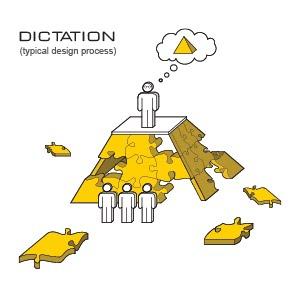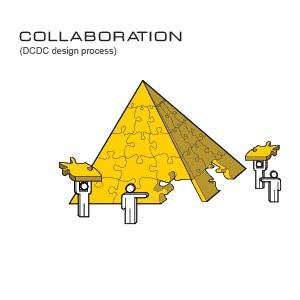DAYLIGHT // S1 E2 - Collaborative Design as a Tool for Social Change

We asked a few citizens to respond the this prompt after attending our DAYLIGHT event on Inclusive Design.
Meg Storrow mentioned that 'Branding for inclusivity is different than designing for it.' And John Hay followed up by stating that community change 'shouldn't start until you've envisioned the future.' In some ways, branding is a way of envisioning the future, but in thinking about inclusive design, who is envisioning this future? And, as Starla pointed out, who is missing from this conversation? For those who are missing, how can designers make sure those people feel welcome in the finished product?
To ask the question of who is missing from the conversation of inclusivity in design and how people feel welcome in the finished product of design poses a unique opportunity to both introspectively question the role of designers and facilitators for the creation of urban environments, while also outwardly seeking the input of those who experience urban culture on the ground. Long standing transformations in community planning, economic development and non-profit work reflect a position of willingness to participate in an engaged, open and cooperative public process. However, in the realm of design, there is still much work to be done in order to develop an inclusive and wholistic practice of design where architects, urban designers and other like-minded creative individuals relinquish years of outmoded means and methods for envisioning and generating design ideas, and supplement with a process which fosters the use of lived experience and community-based interest to develop design solutions for inclusivity.
The beginnings of such conversation were presented in the storyline of a handful of Indianapolis professionals seeking to achieve such inclusivity in Daylight’s Series 1, Episode 2, with two of the four panelists – Justin Ferguson and Meg Storrow – providing the design knowledge background necessary to tackle the topic of the episode, entitled: “Inclusive Design: Urban Renewal & Designing Places for Everyone” from the designer’s perspective. While Justin Ferguson briefly mentioned attitudes of informing, consulting and engaging present in Ball State University’s College of Architecture and Planning’s Master of Urban Design Program and Meg Storrow elaborated on place-based transportation as a neighborhood connector rather than neighborhood divider, neither truly expanded on the importance that such approaches and methodologies bring in developing a culture of inclusivity, or why they are all together important from the start. However, it is these processes and procedures which foster equally, if not far greater, senses of inclusivity than the finished product of design.
Take, for example, the work of the Detroit Collaborative Design Center in Detroit, Michigan or the buildingcommunityWORKSHOP with offices in Washington DC and Dallas, Houston, and Brownsville, Texas. The work being done at the DCDC focuses on collaborative, community processes which lead to thoughtful, inclusive design. “Through difference, thoughtful design that responds to more people can develop without sacrificing quality. This should not suggest that collaboration and participatory design processes ultimately produce thoughtful design…What a collaborative process does do is connect the design and programming to the direct needs and of those typically outside of the design activity” (DCDC). In a similar vein, bcWORKSHOP forms “strong relationships through our collaborative design work, educational outreach activities, and social media channels, enabling us to engage with a broad segment of the population. The success of our work is contingent upon reaching those residents not typically sought out by the design and planning community” (bcWORKSHOP). While ultimately the work produced by both these organizations is creative, innovative, and well-designed all around, it is their processes which set them apart and create a true culture of inclusivity unprecedented in the design world. These processes are how we recognize who is missing from a given conversation. These methods are how we prepare products of design which feel welcoming and engaging. After spending just a few short months working for the DCDC, I can attest to such change in process which ultimately leads to change in attitude and culture.


Some might insinuate that these suggestions of inclusivity and community conversation place far too much weight on the designer to single-handedly solve issues of justice and inclusion plaguing our urban culture. Others might weary at the thought of bringing in more opinions to the design processes, as this can lead to complication rather than clarity. Even a few still might suggest that designers belong solely on the side of making and creating beautiful products of service, while inclusive conversation can be left to the community planners, economic developers, and non-profit workers. Designers have found justification in these beliefs for far too long. Our actions as creators of urban environments serve as our piece in the larger puzzle of creating inclusive culture. It just so happens that our tool, our act of social justice and inclusion, to contribute is design.
__________
Our next episode of DAYLIGHT will be a conversation on Civic Identity through Design. Sign up here.
DAYLIGHT // Season 1, Episode 2: Inclusive Design featured a discussion centered around the urban renewal in Indianapolis. Starla Hart, Program Officer at LISC, moderated the discussion and she was joined by panelists Jeff Bennett, the Deputy Mayor of Community Development for the City of Indianapolis, Meg Storrow, Co-Principal at Storrow Kinsella, John Franklin Hay, Executive Director for NEAR Indy, and Dr. Justin Ferguson, Executive Director of Outreach & Engagement & Director of Master of Urban Design (MUD) Program at Ball State University.

Born and raised an Indianapolis-Hoosier at heart, Bethanie Martin is a graduate from Ball State University with a Bachelors of Art in Architecture. She also holds a dual Master of Architecture and Master of Urban Design from Lawrence Technological University in Detroit, Michigan. She is interested in the intersection of architecture and design with issues of social and racial justice and how designers play a role in providing services to those architecture and urban environments often leave behind. She has thus pushed opportunities in neighborhood engagement, community activism and place-based design while living, working and studying in Detroit, MI. These interests have now taken her to Pittsburgh, Pennsylvania, where she works as an Urban Design and Architecture Fellow at Urban Design Associates. In her spare time, she enjoys supporting local artists, traveling and experiencing cities from the perspective of local residents, and volunteering as a member of the Ball State University Dance Marathon Alumni Association Board.
